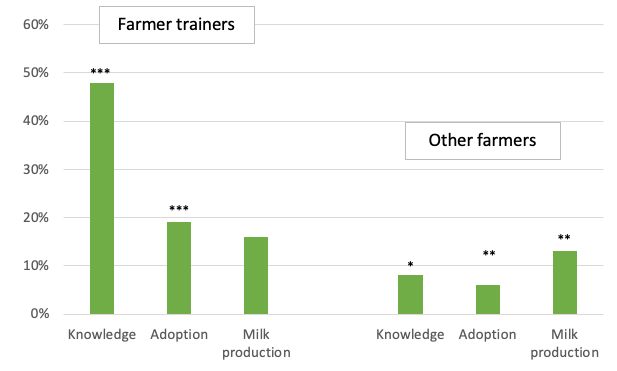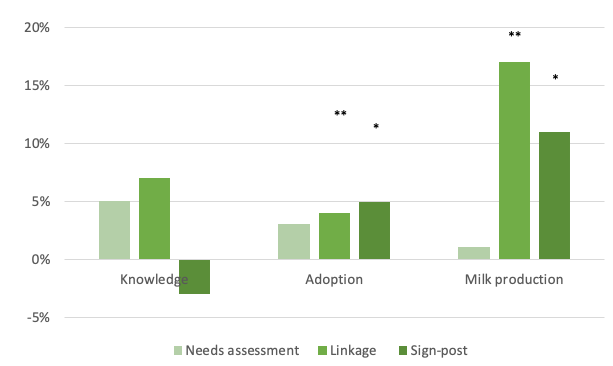
Farmer-to-farmer information diffusion is a cost-effective approach for improving practices and profits for smallholder dairy farmers in East Africa
Low agricultural productivity remains a key development challenge across sub-Saharan Africa. This is not because of a lack of innovations that can help increase agricultural productivity. There are, instead, many different reasons why new technologies or practices are not being adopted. A necessary, if not sufficient, condition is that farmers first need to know about them.
Information barriers: A longstanding challenge with new urgency
The goal of both governmental and non-governmental extension systems is to specifically address information gaps. Appropriate monitoring and incentives for extension agents, challenges in learning about sometimes complex technologies, heterogeneity among farmers and their conditions (which may imply that different messages need to reach different farmers to be useful) together with challenges to reach farmers who often live in remote areas have led to questions on the feasibility of cost-effective extension (Anderson and Feder 2007).
A pessimistic view persists among many policymakers and development agencies today. While the transmission of simple messages with agricultural information through mobile technologies offers new opportunities to reach many farmers (Fabregas et al. 2019), it may not be appropriate for the scaling of more complex innovations.
There are many open questions on how best to overcome information barriers for smallholder farmers in sub-Saharan Africa (de Janvry and Sadoulet 2019). These questions have an even higher urgency when considering the scaling of climate smart innovations or other technologies with positive environmental externalities.
For instance, there are have been a lot of scientific advances in combining improvements in animal health, breeding, and feeding practices to simultaneously increase efficiency and reduce the environmental footprint of smallholder dairy farming in sub-Saharan Africa (Havlik et al. 2014). To reap the benefits of these advances, smallholders need to become aware of this potential.
Farmer trainers and agricultural information diffusion in Uganda
In a recent study (Behaghel, Gignoux and Macours 2020) we asked the following questions: Can training volunteer ‘farmer trainers’ (FTs), who are then asked to disseminate information about agricultural technologies to other farmers, increase the coverage and impact of agricultural extension services? And how do you ensure that those farmer trainers have sufficient knowledge, credibility, and incentives to fulfil this task?
Approaches that give a more active role to farmers have spread rapidly over past decades. While they can decrease the cost per farmer reached, little rigorous empirical evidence is available on their impacts on farm productivity and profitability, meaning cost-effectiveness remains unclear. Indeed, while such models can keep monetary costs low – by training only a small share of targeted farmers and then relying on their prosocial motivation and other non-monetary incentives (such as enhanced social status) to diffuse knowledge – this will only be worth doing if it leads to effective knowledge transfers, technology adoption, and productivity increases among a larger group of farmers.
To begin to fill this evidence gap, we evaluated the impact of a programme operated by the World Agroforestry Center (ICRAF), which trains volunteer farmer trainers on multiple strategies to improve feeding of their dairy cows. Highly qualified technicians with a deep knowledge of different feeding practices trained the farmer trainers, who in turn trained other farmers in their villages.
The programme was part of the broader East Africa Dairy Development Project (EADD) in Kenya, Uganda, and Tanzania. Improvement in feeding practices promoted by the farmer trainer programme was seen as a direct complement to the EADD’s breeding, health, and marketing components. By ensuring crosses have higher milk yields through better feeding and health, milk supply is sufficient and sufficiently stable to attract buyers, in turn providing feedback incentives to adopt (and promote) these new practices.
Training farmers in villages in Busoga
The evaluation was based on a randomised control trial taking advantage of the rollout of the farmer trainer programme in the Busoga region of Uganda. The impact was measured after two years, by comparing 411 treatment villages that received farmer trainers in year one, to 216 control villages that received them only in year three.
Among treated villages, we also tested the impact of three variations aimed to increase the programme’s effectiveness, by providing (cross-randomised) subsets of farmer trainers with:
- Linkage variation: Vouchers that cover the cost of visits by local professional extension agents to the farmer trainer.
- Needs assessment variation: Extra training to adjust their teaching to the specific needs of fellow farmers.
- Signpost variation: A metallic signpost to put in front of their compound indicating that they are farmer trainers.
We collected information on farmers’ feeding practices, dairy production, and revenues before the programme began, one year after the programme started, and at the end of the programme. This was complemented with monitoring data and three rounds of qualitative data.
Positive impacts on information, practices, production, and profits
The programme had positive impacts all along the hypothesised causal chain, from knowledge among farmer trainers to knowledge, technology adoption, production, and profits among farmers in their village. Impacts on farmer trainers’ knowledge are large (+48% standardised effect) and are transmitted to other farmers (+8% standardised effect).
Farmer trainers and other farmers reported increased use of feeds and feeding practices, and planting more feeds on their plots. Milk production itself increased by about 13% of a standard deviation. Objective measures obtained through surprise visits during milking sessions at a subsample of farms confirmed these results. They also showed significant increases in cows’ weight, consistent with better feeding. Last, impacts on profits were positive, though not very precisely estimated.
Importantly, the signpost and linkage variations – add-ons to the basic farmer training programme with relatively low marginal costs – substantially augmented the positive impacts on milk production and profits. This can be explained by improved access to technical information, increased incentives and motivation of farmer trainers, higher social interactions regarding dairy farming, and increased credibility of the trainers.
Figure 1 Impact of the programme on farmer trainers and farmers

Note: All effects are standardised (expressed in % of the standard deviation in the control group). Being trained as a farmer trainer increased one’s knowledge standardised score by 48% in a knowledge test on feeds and beneficial feeding practices; living in a village with such a farmer trainer increased the knowledge score by 8%. ***: significant at 1% level; **: significant at 5% level; *: significant at 10% level.
The farmer-to-farmer model: Heterogeneity and information diffusion
Many innovations may be profitable on average while at the same time not being profitable for a (large) share of farmers (Suri 2011). Such heterogeneity in turn can complicate social learning (Munshi 2004) and therefore the effectiveness of farmer-to-farmer training. The design of the farmer trainer programme attempted to account for such heterogeneity. It started from an assessment of dairy farmers’ needs in the region and taught a broad set of feeding principles, as opposed to (just) a narrow set of specific practices.
The farmer trainers may also be sufficiently representative of other farmers in the village and could use local information regarding other farmers’ needs to adjust the information they pass on based on those insights. We hypothesised that further enhancing farmer trainers’ ability to account for heterogeneity could enhance knowledge diffusion. But the experimental variation designed to test this customisation – by training a subset of farmers in a special needs assessment module – showed no differential impacts.
Several additional pieces of analysis, both data-driven and theory-driven, indicate that heterogeneity did not limit social learning within villages. Possibly, the programme design allows for automatic customisation, as farmer trainers are well placed to pass on the specific knowledge they deem most relevant for their fellow farmers, allowing them to ‘teach at the right level’.
Figure 2 Impact of programme variations on farmers

Note: All effects are standardised (expressed in % of the standard deviation in the control group). Regular visits of the extension agent to the farmer trainer increased the adoption of feeding technologies and practices by farmers in the village by 4% of a standard deviation, compared to villages in which the programme was not complemented by such linkage. Daily milk production increased by 17% of a standard deviation. ***: significant at 1% level; **: significant at 5% level; *: significant at 10% level.
Policy implications: A cost effective model for smallholder dairy farmers in East Africa
Based on farmers’ and farmer trainers’ increased profits and on the programme costs, the overall programme is cost-effective (with a net gain of US$454 per village per year), due to the fact that the increase in milk production is obtained at a very low cost per farmer. The linkage and the signpost, which substantially increased profits while only accounting for a small part of the programme cost, led to additional net gains of about $1,700 a year.
Overall, the study shows that a farmer-to-farmer approach to extension that starts from high-quality training of the farmer trainers can be effective and help scale agricultural innovations, even when relying on low-cost non-monetary incentives. It also shows that reinforcing this approach with backstopping of professional extension agents is promising, possibly because it combines the benefits from social learning and local information with the advantages of in-depth, science-based knowledge and credibility.
Augmenting incentives and credibility through low-cost measures, like signposts, can also have high returns. Given the relatively large scale of the programme evaluated and its inclusion in a much larger programme that uses similar approaches across several countries, the study arguably has broad relevance for mixed livestock-cropping systems in East Africa. More generally, it suggests the promise of cascade models for information dissemination and scaling in rural settings.
References
Anderson, J R and G Feder (2007), “Agricultural Extension”, in R Evenson and P Pingali (eds), Agricultural Development: Farmers, Farm Production and Farm Markets, Handbook of Agricultural Economics, Volume 3, Elsevier, pp. 2343 – 2378.
Behaghel, L, J Gignoux and K Macours (2020), “Social Learning in Agriculture: Does Smallholder Heterogeneity Impede Technology Diffusion in Sub-Saharan Africa?”, CEPR Discussion Paper 15220.
de Janvry, A and E Sadoulet (2019), “Transforming developing country agriculture: Removing adoption constraints and promoting inclusive value chain development”, HAL Working Paper hal-02287668.
Fabregas, R, M Kremer and F Schilbach (2019), “Realizing the potential of digital development: The case of agricultural advice”, Science 366(6471).
Havlik, P et al. (2014), “Climate change mitigation through livestock system transitions”, Proceedings of The National Academy of Science 111(10): 3709–3714.
Munshi, K (2004), “Social learning in a heterogeneous population: technology diffusion in the indian green revolution”, Journal of Development Economics 73(1): 185 – 213.
Suri, T (2011), “Selection and comparative advantage in technology adoption”, Econometrica 79(1): 159–209.


